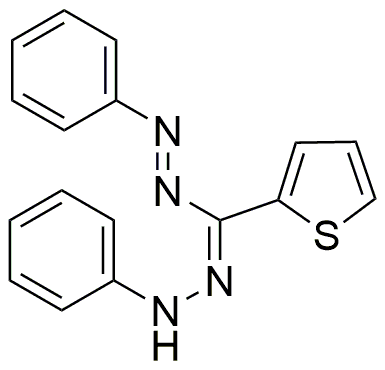1,5-Diphenyl-3-(2-thienyl)formazan is widely utilized in research focused on:
- Analytical Chemistry: This compound serves as a colorimetric reagent for the detection of metal ions, providing a simple and effective method for quantifying trace elements in various samples.
- Organic Synthesis: It acts as a versatile intermediate in the synthesis of other organic compounds, facilitating the development of new materials and pharmaceuticals.
- Biological Research: The compound has shown potential in studying biological processes due to its ability to interact with specific biomolecules, making it useful in drug discovery and development.
- Photovoltaic Applications: Its unique electronic properties make it suitable for use in organic solar cells, contributing to advancements in renewable energy technologies.
- Colorimetric Sensors: The compound can be incorporated into sensor devices for environmental monitoring, allowing for the detection of pollutants and enhancing safety in industrial settings.
General Information
Properties
Safety and Regulations
Applications
1,5-Diphenyl-3-(2-thienyl)formazan is widely utilized in research focused on:
- Analytical Chemistry: This compound serves as a colorimetric reagent for the detection of metal ions, providing a simple and effective method for quantifying trace elements in various samples.
- Organic Synthesis: It acts as a versatile intermediate in the synthesis of other organic compounds, facilitating the development of new materials and pharmaceuticals.
- Biological Research: The compound has shown potential in studying biological processes due to its ability to interact with specific biomolecules, making it useful in drug discovery and development.
- Photovoltaic Applications: Its unique electronic properties make it suitable for use in organic solar cells, contributing to advancements in renewable energy technologies.
- Colorimetric Sensors: The compound can be incorporated into sensor devices for environmental monitoring, allowing for the detection of pollutants and enhancing safety in industrial settings.
Documents
Safety Data Sheets (SDS)
The SDS provides comprehensive safety information on handling, storage, and disposal of the product.
Product Specification (PS)
The PS provides a comprehensive breakdown of the product’s properties, including chemical composition, physical state, purity, and storage requirements. It also details acceptable quality ranges and the product's intended applications.
Certificates of Analysis (COA)
Search for Certificates of Analysis (COA) by entering the products Lot Number. Lot and Batch Numbers can be found on a product’s label following the words ‘Lot’ or ‘Batch’.
*Catalog Number
*Lot Number
Certificates Of Origin (COO)
This COO confirms the country where the product was manufactured, and also details the materials and components used in it and whether it is derived from natural, synthetic, or other specific sources. This certificate may be required for customs, trade, and regulatory compliance.
*Catalog Number
*Lot Number
Safety Data Sheets (SDS)
The SDS provides comprehensive safety information on handling, storage, and disposal of the product.
DownloadProduct Specification (PS)
The PS provides a comprehensive breakdown of the product’s properties, including chemical composition, physical state, purity, and storage requirements. It also details acceptable quality ranges and the product's intended applications.
DownloadCertificates of Analysis (COA)
Search for Certificates of Analysis (COA) by entering the products Lot Number. Lot and Batch Numbers can be found on a product’s label following the words ‘Lot’ or ‘Batch’.
*Catalog Number
*Lot Number
Certificates Of Origin (COO)
This COO confirms the country where the product was manufactured, and also details the materials and components used in it and whether it is derived from natural, synthetic, or other specific sources. This certificate may be required for customs, trade, and regulatory compliance.


